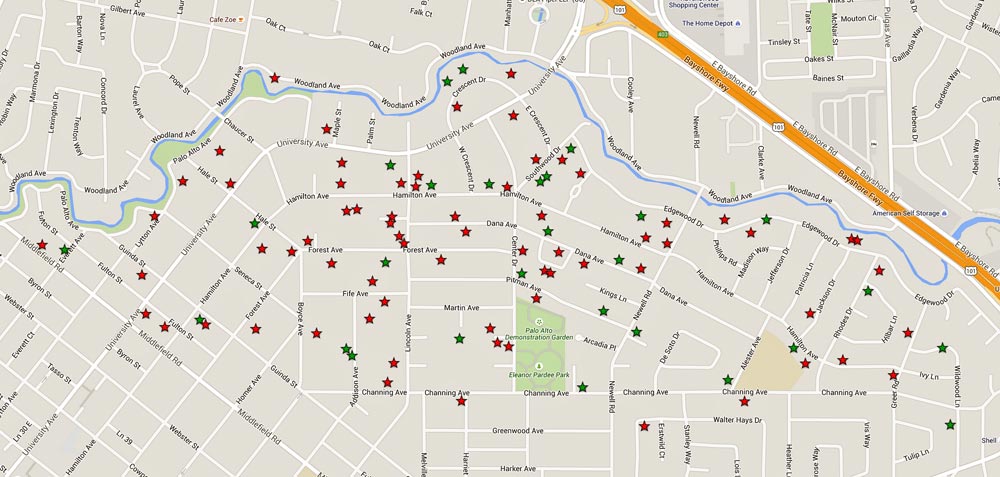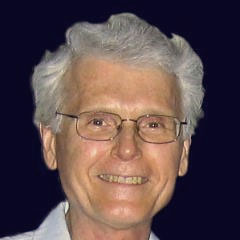
In order to make the impact of aircraft overflight noise intrusions more concrete (as a complement to the abstract indications in the map data shown in the Background page), I did two studies: (a) I made recordings of the perceived aircraft noise levels relative to normal TV audio in our home during evening heavy traffic times (roughly 5:00 PM to 11:00 PM), and (b) I investigated the impact and geographic distribution of noise disturbances among the Crescent Park Neighborhood Association membership.
Intrusive Noise Recordings
I used an Olympus VN722PC digital audio recorder set for group-meeting-record mode (i.e., omni-directional microphone). On a warm evening (Friday, June 12, 2015 — a day of the week with quite heavy air traffic), I placed the recorder next to the couch where my wife and I sit to watch TV. Our patio sliding door was open for fresh air, and I recorded the sounds from about 5:30 PM to 10:30 PM. From about 5:30 PM to about 7:30 there was only neighborhood background noise, and from 7:30 PM to 10:30 we were watching TV.
I transferred the MP3 file to my computer and used GoldWave professional digital audio editor to analyze the wave forms. Between 5:30 PM and 7:30 PM I detected 36 “significant” aircraft fly-over events, with peak sound levels between 10 and 20 db above the ambient background. This count of fly-over events is conservative as some did not rise significantly above background to be discernible in the waveform trace. This means we had an average of about 17 loud fly-overs per hour, or one every 3.5 minutes, during this period.
When we started watching TV, the background sound level (with TV audio) rose by about 10 db. During the TV-watching period, I selected areas of the recorded audio during overflights that were high enough above the ambient TV audio as to interfere badly with listening. During the 3 hours we were watching TV, I found 22 such examples (an average of 7.3 events per hour, or one every 8.2 minutes!).
In order to fully illustrate the intrusion of this aircraft noise, I split out these events into a separate MP3 recording (playback button below) in which each event (about 1 min long) starts where the TV is audible, followed by the overflight interference, and finally followed by a short period where the TV again becomes audible. Each such event is separated from the next by 3 seconds of silence. Nothing has been done to the recording to emphasize the aircraft noise relative to the TV audio in any way. The full recording length is 23 minutes.
As further context, the TV programs we watched during this recording were from our TiVo DVR and included parts of the PBS NewsHour, Jon Stewart’s Daily Show, an episode from The Doctor Blake Mysteries, and an episode from ImageMakers – thus the program times do not correspond to the wall-clock times of my audio recordings.
Extent of Noise Impact: Population and Geographic Distribution
In order to get an idea of how many people in the Crescent Park neighborhood are being affected by aircraft noise, and to discern if there might be any interesting geographic distribution of noise problems, I asked members of our Crescent Park Neighborhood Association (CPNA) to email me with their assessment of whether or not the noise was seriously intrusive. The CPNA membership includes 575 households and covers an area in the north end of Palo Alto bounded by Channing Ave, Middlefield Rd, and San Francisquito creek.
My poll was active for about two weeks at the end of June and I heard from 98 households about their perceptions of aircraft overflight noise (see Table 1). Over the two weeks that I collected these data, the percentage split in responses was quite stable.
| Impact of Noise | Count | Percent | Map Color |
|---|---|---|---|
| Noise very disturbing | 70 | 71% | Red |
| Noise not a problem | 28 | 29% | Green |
| Total | 98 | 100% |
I also collected the addresses of the households responding and plotted their location on a Google map, with green stars showing houses where the noise is “no problem or tolerable” and red stars where the noise is “very disturbing”.

There does not seem to be any particular geographic clustering for where the noise intrudes and where it does not. In particular, people living essentially next door have opposite assessments. It seems that the effects are felt everywhere in Crescent Park, and that the intrusiveness of the perceived noise changes from place to place fairly randomly, depending on the local situation at each house (e.g., does a house use heating/air conditioning most of the time so that windows stay closed; are some houses better insulated against outside sound than others; are there exterior structures like walls second stories around the property that reflect sounds; are some people more sensitive to noises than others or do they have more acute hearing; do some families spend more time outside than others; are the living areas of houses facing different directions so that flights heading generally SE to NW to land at SFO would affect some more than others; …).
As noted above, the relative percentages of the responses have stayed about the same as comments have accumulated – although some households have changed their vote from “no problem or tolerable” to “very disturbing” as warm weather has set in so more windows are open and people are outdoors. I should also note that these results are self-reported (i.e., not randomized) so one might expect people angry at the aircraft noise to speak out more actively. How big this effect might be is unknown — although I have not known this community to be bashful about expressing their opinions if they have time and interest in responding.
Bottom Line and Resolution Sought
The bottom line of all this is that the recent shift of the SFO aircraft approach management control region to above the Palo Alto Crescent Park neighborhood is extremely intrusive (intolerably so in my opinion) on many daily activities. My example of interfering with watching TV would hold equally true of a backyard BBQ, a party, or just enjoying a quiet summer evening on the patio. We have lived in our Palo Alto home for over 30 years and have never had this kind of problem with aircraft noises during that time, until the recent flight control changes were put into effect.
We would very much like to see this new regime reconsidered and changed so that this overflight approach assembly area is moved from Crescent Park to the bay or some other more lightly populated area (perhaps toward the regional open space properties).
Tom Rindfleisch
6/14/15

